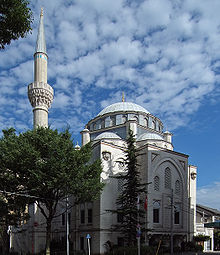Hilmi Şenalp
Muharrem Hilmi Şenalp | |
|---|---|
| Born | 1957 (age 67–68) Konya, Turkey |
| Nationality | Turkish |
| Alma mater | Istanbul Technical University Yıldız Technical University |
| Occupation | Architect |
Muharrem Hilmi Şenalp (born 1957 in Konya, Turkey) is a Turkish architect. His work is often inspired by Ottoman architecture. He has been called Turkish president Recep Tayyip Erdoğan's "court architect", and is a close friend of the president. His company, Hassa Architecture, specializes in neo-Ottoman style. Şenalp takes inspiration from 16th century architect Mimar Sinan, who worked for Suleiman the Magnificent.[1][2]: 56–57 [3]
Early life and education
[edit]He attended high school in Konya, and graduated from the Istanbul Technical University in 1981.[2]
Works
[edit]
His work include the new Tokyo Mosque in Japan,[4] the Ertuğrul Gazi Mosque in Turkmenistan,[2]: 62 the Şehitlik Mosque in Berlin,[2]: 56 and the Diyanet Center of America in Maryland, U.S.[5]
Kishwar Rizvi, professor of Islamic art, says "Hilmi Şenalp's mosques are a signature of Turkish identity, exported through the diaspora as reminders of the home nation, and built in foreign lands as diplomatic gifts of brotherhood."[2]: 66 [6] She states that the mosques, sponsored by the Turkish government, seems to equate ethnicity with religious identity, and compares him with Vedat Dalokay, who designed the Faisal Mosque in Islamabad. Şenalp says "The mosque is the heart of our civilization, Turkish-Islamic civilization."[2]: 28, 199 A SETA Foundation publication says "Beyond doubt, the architectural designs of Şenalp, whether traditional or contemporary, is a deliberate manifestation of a quest for identity of its architect and of its sponsors. This approach reinterprets the traditional forms in such a way that it is related to the past, history and memory."[7]
Other projects include the Mimar Sinan Mosque in Ataşehir, Istanbul, one of Erdoğan's residences and a monument commemorating victims of the 2016 Turkish coup d'état attempt.[8][9][10][11]
References
[edit]- ^ "Has AKP sacrificed Turkey's Ottoman heritage? - Al-Monitor: the Pulse of the Middle East". Al-Monitor. 18 February 2015. Retrieved 15 May 2020.
- ^ a b c d e f Rizvi, Kishwar (2015). The Transnational Mosque: Architecture and Historical Memory in the Contemporary Middle East. University of North Carolina Press. ISBN 978-1-4696-2117-3. Retrieved 15 May 2020.
- ^ "Recep Tayip Erdoğan Külliyesi'ni 'ailecek' yapacaklar". Sözcü (in Turkish). 9 June 2018. Retrieved 17 May 2020.
- ^ "Turkish state body TIKA organizes iftar in Japan". Anadolu Agency. Retrieved 15 May 2020.
- ^ "Largest mosque in US features Ottoman design". Daily Sabah. 31 March 2016. Retrieved 15 May 2020.
- ^ "Kishwar Rizvi | Department of the History of Art". arthistory.yale.edu. Yale University. Retrieved 15 May 2020.
- ^ Yaslıçimen, Faruk (1 April 2016). "Diyanet Center of America: An Architectural Quest for Identity". Politics Today. SETA Foundation.
- ^ Ay, Hasan (19 June 2017). "Monument at bridge entrance tribute to July 15 coup victims". Daily Sabah. Retrieved 15 May 2020.
- ^ "Başbakan'ın evinin mimarı da bu görüntüye karşı". Hürriyet (in Turkish). 17 October 2011. Retrieved 16 May 2020.
- ^ "ucus noktasi" (PDF). August 2017. p. 17. Retrieved 17 May 2020.
- ^ Batuman, Bülent (2017). New Islamist Architecture and Urbanism: Negotiating Nation and Islam through Built Environment in Turkey. Routledge. ISBN 978-1-317-35800-8. Retrieved 17 May 2020.
External links
[edit]- Muharrem Hilmi Şenalp at Hassa Architecture
